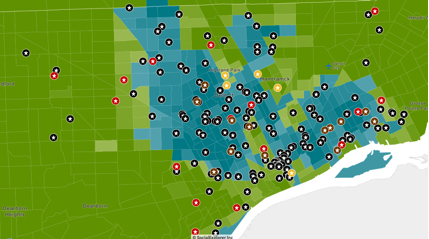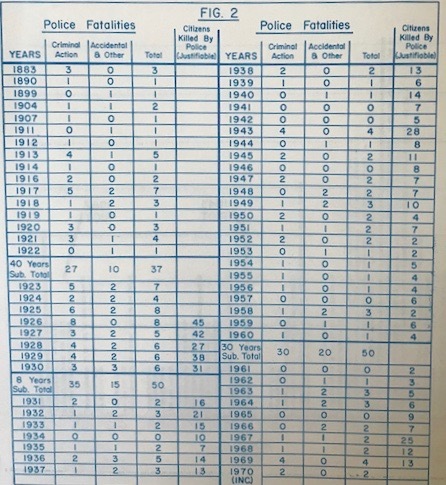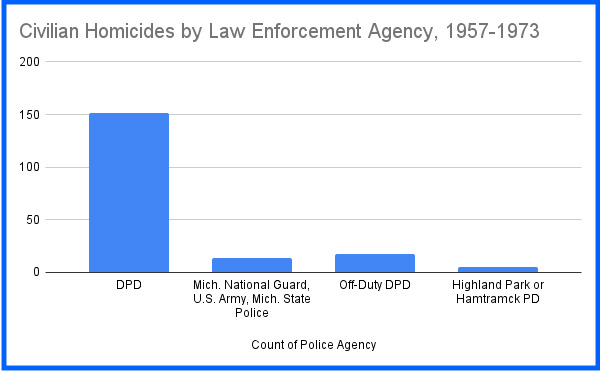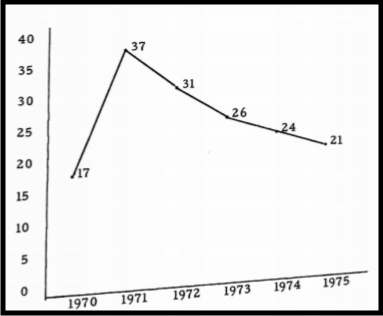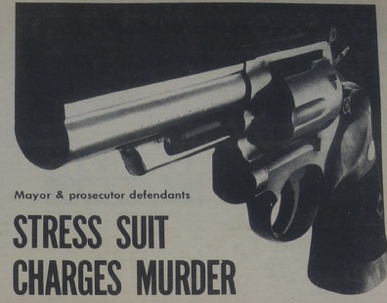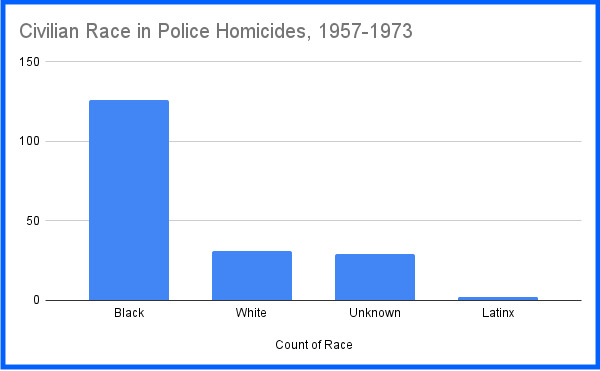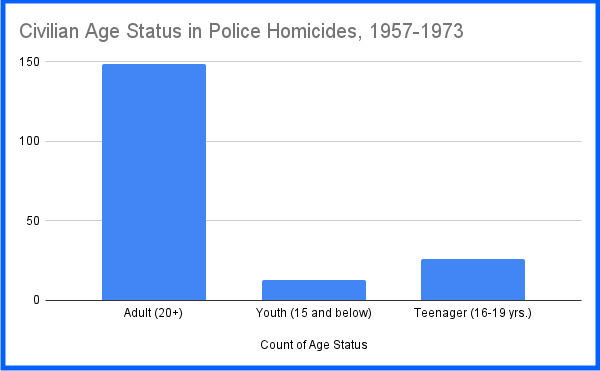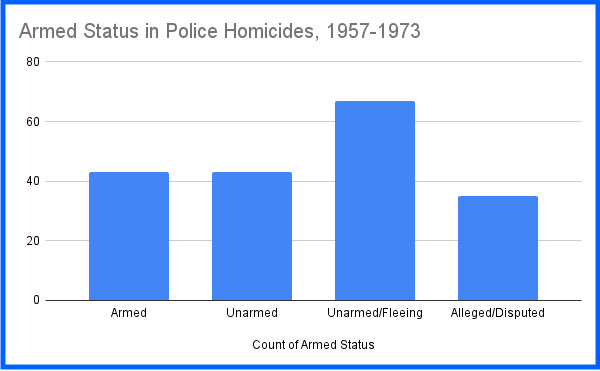Mapping Police Homicide Patterns in Detroit, 1957-1973
This overview page provides four maps of all of the police homicides in Detroit identified by our research team for the 1957-1973 time period examined in Detroit Under Fire. The maps reveal police homicide patterns by law enforcement agency, by race, by age, and by unarmed/armed (alleged) status. Detailed pattern analysis and dozens of case studies are available on the police homicides pages for each of the five sections of the exhibit: 1957-1963, 1964-1966, 1967, 1968-1970, and 1971-1973.
Key Findings (elaboration in map sections below)
- 75% of officially acknowledged on-duty Detroit Police Department homicides have been identified by our project (151 of 201).
- At least 37 additional people were killed by off-duty DPD officers or other law enforcement agencies between 1957-1973.
- 79% of police homicides between 1957-1973 where race can be determined were of African Americans.
- At least 59% of police homicides were of unarmed civilians, and in another 19% the armed status is only alleged/contested not confirmed. Only 23% of police homicides involved cases where the person killed appears clearly to have been armed and posing a direct threat.
- 21% of police homicides were of teenagers or preteens (92% were unarmed).
- At least 25% of police homicides either met the legal standard for bringing murder or manslaughter charges, or probably did but involved coverups that should have been thoroughly and impartially investigated, in our project's assessment.
- A majority of police homicides involved excessive and unnecessary force, even if technically "justifiable" by state law and DPD policies designed to grant maximum discretion to officers and that allowed use of fatal force to prevent fleeing "suspects" of low-level crimes from escaping.
- The Wayne County Prosecutor declared all on-duty police homicides to be "justifiable" except for five. Three resulted in murder prosecutions (each charged officer was acquitted).
- The Detroit Police Department routinely covered up the circumstances of police homicides, and the Wayne County Prosecutor routinely whitewashed investigations.
Overview. The Detroit Police Department (DPD) officially acknowledged 201 "justifiable homicides" of civilians by its on-duty officers between 1957 and 1973. More than half (111) came during 1970-1973 alone, when the DPD was the deadliest police department per capita in the nation. The DPD did not make these totals public, and our research team discovered the aggregate data through two archival documents hidden for decades (reproduced at right and below). The official total is definitely an undercount, part of the broader pattern of disguising the full scope of state violence, not least because law enforcement and prosecutor archives are closed except for expensive, time-consuming, and often unsuccessful Freedom of Information Act requests. The names of the people killed by DPD officers are also not readily available, except through research for traces left in non-police archives and laborious keyword searches in newspaper databases that only reported on some police homicides and, in most cases, only included the police version of what happened.
The Policing and Social Justice HistoryLab research team has identified 188 homicides by police officers in Detroit between 1957 and 1973. This includes 151 by on-duty DPD officers, representing around 75% of the acknowledged total (although at least 5 of the on-duty killings we have documented were covered up and not in the official number). The research team also has uncovered 18 homicides by off-duty DPD officers, a subset of an unknown total, and documented 19 additional killings of civilians by other law enforcement agencies (most during the military occupation of Detroit during the 1967 Uprising).
188 Police Homicides in Detroit, 1957-1973, by Law Enforcement Agency
The interactive map below documents all 188 police homicides discovered by our research team in the racial geography of Detroit based on the 1970 census. The darkest blue areas represent segregated Black neighborhoods, and the darkest green indicate all-white sections of the city. Hover over the dots to read an incident description and see the source. Zoom the map to view the large cluster in the downtown-midtown business corridor and in the most segregated Black areas of the city's East Side and West Side. (Note: Some of the homicides from the late 1950s and early 1960s will appear to be in census tracts with a different racial composition than is indicated on this map because of the shifting color line, but the vast majority of police killings during this era took place during the late 1960s and early 1970s).
Map 1: Police Homicides by Agency, 1957-1973, in Detroit's Racial Geography (1970 Census)
- Black circles (151) = Detroit Police Department Officers (On-Duty)
- Red circles (18) = Detroit Police Department Officers (Off-Duty)
- Brown circles (14) = Michigan National Guard (11), U.S. Army (1), and Michigan State Police (2); all but one occurred during the occupation of Detroit during the 1967 Uprising
- Yellow circles (5) = Highland Park (3) or Hamtramck (2) Police Departments (small municipalities inside the city of Detroit)
Scroll down to view maps of the same homicides by race, age, and unarmed/armed status
State Violence vs. "Justifiable Homicides"
Civil rights groups and individual families protested many of these homicides and accused the DPD of excessive force and even murder in a significant number of cases. State law and DPD policy, as documented in each section of the exhibit, gave police officers extraordinary discretion to use deadly force, including against unarmed and fleeing "suspects" of even minor crimes such as burglary. The Wayne County Prosecutor, responsible for the city of Detroit, declared all on-duty police homicides between 1957 and 1973 to be "justifiable" except the white officers who murdered three Black teenagers at the Algiers Motel during the 1967 Uprising (they were acquitted), an incident when officers shot a licensed private guard, and one by an undercover narcotics officer likely linked to drug corruption. The prosecutor also charged five police officers for off-duty homicides during this time period (that our project has identified); all but one were acquitted by jury trial. Civil rights groups repeatedly accused the prosecutor of systematic racism and constitutional violations in the justification of deadly force by police officers, no matter what the circumstances. A civil rights coalition filed a 1964 complaint with the Michigan Commission on Civil Rights accusing the Wayne County Prosecutor of a pattern of racial discrimination in the determination of "justifiable homicides," and activist groups ultimately filed a conspiracy lawsuit in 1972 that charged the prosecutor with mass deprivation of the civil rights of Black people in Detroit by colluding with the DPD to exonerate "police officers whom he knows are guilty of vicious criminality."
Excessive Force and Wrongful Death. In the assessment of our research project, a large majority of the police homicides in Detroit between 1957 and 1973 involved excessive force and wrongful death, which is a standard often used in civil litigation. This analysis implicates police department policies as much as, or even more than, individual officers. Almost two-thirds of the people killed by law enforcement officers in Detroit were unarmed and not posing a threat to anyone when shot, including almost all of the 39 teenagers and preteens who lost their lives in fatal force encounters (see maps below). The DPD's extremely permissive and discretionary "use of force" rules allowed--and in the early 1970s the DPD hierarchy even actively encouraged--police officers to shoot unarmed people in the back as long as the officer claimed that he believed the individual to be a "fleeing felon." This authorization further gave police officers a predetermined script to justify fatal force regardless of what actually happened on the ground--the suspect fled, the officer claimed to yell 'halt,' the suspect kept running, the officer fired--that the DPD Homicide Bureau automatically accepted and that the Wayne County Prosecutor always did as well, even when eyewitness testimony and forensic evidence clearly contradicted the police account. In addition, almost 40% of the verifiably armed cases involved mental health emergencies or domestic disturbance situations, most of which responding police officers escalated by bursting onto the scene with guns drawn. These homicides usually involved excessive--if technically legal--force and implicate DPD training and deployment policies as much as the individual officers on the scene. In the vast majority of cases, the police officer shot and killed, the newspapers published a brief notice based solely on the police report (if they covered the incident at all), and there was no substantive or impartial investigation of what actually happened.
A Pattern of Police Coverups of Potential Murder/Manslaughter Scenarios. Our project findings, which build on contemporary documentation by civil rights groups, reveal that at least 25% of the 188 identified homicides definitely or probably met the legal standard for murder or manslaughter charges at the time, even under the deliberately permissive state laws and police department policies. Almost all of these were covered up or whitewashed by a combination of the officers on the scene and their superiors, the DPD Homicide Bureau, and the Wayne County Prosecutor. (The prosecutor should have taken an even higher percentage of police homicides to the grand jury for witness testimony and fact-finding independent of the DPD Homicide Bureau). The cases where the evidence indicates murder include at least 18 teenagers whose stories are documented in depth on exhibit pages: of Virgil Miller (1957) and Albert Morris (1959); of David Carson (1962) and Kenneth Evans (1963); of Clifton Allen (1964) and arguably Nathaniel Williams (1964); of William Dalton, Fred Temple, Aubrey Pollard, and Carl Cooper during the 1967 Uprising (officers were acquitted in two of these four cases); of Jimmy Matthews (1968), Chucky Howell (1969), and Fernando Gonzalez (1969); of Ricardo Buck (1971) and Craig Mitchell (1971); of Curtis McConnell (1972) and Graham Harrison (1972) and Charles Smith (1972). In three cases--the murder of Cynthia Scott in 1963, and the STRESS killings of teenagers Ricardo Buck and Craig Mitchell in 1971, the Policing and Social Justice HistoryLab has acquired the DPD Homicide Bureau's investigative files through the Freedom of Information Act and done an exhaustive analysis demonstrating without question that the police department and the prosecutor covered up what really happened. At least 21 of the 35 homicides by law enforcement during the 1967 Uprising likely did not meet the legal standard for "justifiable homicides," according to eyewitness testimony and forensic evidence discounted or ignored by the DPD Homicide Bureau and Wayne County Prosecutor, including all or almost all of the 11 people killed by the Michigan National Guard, and a number of alleged "looters" shot by DPD officers without cause, including three African American males who were actually in custody and arguably murdered. There is considerable evidence that many Detroit police officers carried "drop knives" to plant on people that they killed in order to fabricate a "justifiable homicide" crime scene; at least seven of the homicides by the undercover STRESS unit of the early 1970s, which planted weapons on dead civilians routinely, resulted in wrongful death civil lawsuit settlements or jury verdicts. All 16 of the homicides by the STRESS decoy operation during 1971-1972 were deeply suspicious or clearly criminal. Based on eyewitness testimony and forensic evidence, there is little question that white law enforcement officers covered up murders or manslaughters of a Black man named James Sabra (1965) shot without cause in his backyard, a white man named Charles Calloway (1970) beaten and killed for allegedly disrespecting an officer, a 57-year-old Black man named Durwood Foshee (1972) shot by more than a dozen police in his bedroom, a Black man named Robert Slaughter (1973) beaten to death in custody in a law enforcement lynching after he shot a police officer, and multiple other cases as well. Off-duty DPD officers killed Black and white civilians in road-rage responses to traffic accidents; corrupt narcotics police executed drug dealers who were not on their payroll; white police officers shot and killed Black men, such as Joe Nathan Nealey (1971), just for asserting their legal rights during racial profiling traffic stops. The Wayne County Prosecutor exonerated Detroit Police Department officers in all but five of the on-duty homicides, and none was convicted.
188 Police Homicides in Detroit, 1957-1973, by Race
Around 80% of the police homicides where race can be identified were of African Americans (126 of 159). White people represented one-fifth of the racially identifiable homicides, and police officers also killed two Latino teenagers. It is likely that the homicides where race is unidentified roughly break down alone the 80% Black/20% white pattern. (96% of the police homicides were of people identified as male).
Black residents made up 29% of the total Detroit population in 1960 and 44% in 1970. In general, the police killed African Americans at around double their percentage of the population through the late 1960s, and between 5-to-6 times the rate of white people during this era overall. Around two-thirds of those killed by police during the decade before the 1967 Uprising were African American. The summer of 1967 was an escalation point in police violence, as Black residents made up 86 percent of those killed by law enforcement during the Uprising (all but one of the white fatalities were accidental). Nearly 90% of identifiable fatalities were African American during the militarized, racially targeted crackdown on young Black males depicted as a "street crime" threat during the late 1960s and especially the STRESS era of 1971-1973.
African Americans were far more likely to be shot and killed in the downtown business corridor and along the racial boundaries that separated white and Black neighborhoods, whereas white homicides predominated among the relatively small number that occurred in the all-white outlying parts of the city (see map below). Otherwise, the racial patterns of the incidents in which white and Black people were killed by the police differed more by degree than kind, notwithstanding the much higher police homicide rate for African Americans. The white adults killed by police were somewhat more likely to have felony criminal records and be "armed and dangerous"--usually an armed robbery scenario that involved gunfire--than the African American adults killed by the DPD, especially before 1967. One-third of the overall white fatalities involved teenagers or young adults who were fleeing from property crimes and unarmed, whereas about half of the homicides of their Black counterparts fell into this category, again at a much greater scale. Black teenagers, as recounted below, were the most likely to be unarmed and fleeing when shot, as were younger Black adults. Visit the "Police Homicides" pages for each section of the exhibit for more details and analysis.
Map 2: Police Homicides by Race, 1957-1973, in Detroit's Racial Geography (1970 Census)
- Black circles (126) = African Americans [79% of the race known total]
- Red circles (31) = White [19% of the race known total]
- Blue circles (2) = Latinx [1% of the race known total]
- Yellow circles (29) = Race Undetermined
188 Police Homicides in Detroit, 1957-1973, by Age Status
The excessive and wrongful use of deadly force by the Detroit Police Department was most evident in the killings of teenagers, who represented one-fifth of the total homicides. Almost all (34) of the 37 teenagers and 2 preteens killed by police were unarmed, a case-by-case classification made by our project that is sometimes based on conflicting evidence and therefore includes several incidents where we assess that police officers planted knives or other weapons on youth after killing them.
Most of the teenagers killed by police were fleeing from the scene of alleged low-level property crimes and shot in the back, which was legally justified "to prevent escape" under the extremely permissive rules governing "use of firearms" by law enforcement. At least 21 of the 27 African American teenagers were killed this way, unarmed and fleeing, along with 3 white youth and 3 more whose race is unidentified. (A few unarmed Black males classified as "fleeing" appear to have been shot from the front and then framed as fleeing to 'justify' the homicide). A clear pattern emerges from analyzing the location of unarmed African American teenagers killed by the police (blue and orange circles in the map below): most were shot along the racial boundary lines between Black and white neighborhoods or along major commercial corridors, especially as African American residents began moving into the all-white sections of Northwest Detroit. This pattern indicates a DPD deployment policy to uphold the color line and to protect white-owned businesses and residences from minor crime with fatal force.
Around half of the homicides of teenagers during this era involved circumstances that arguably should have resulted in murder or manslaughter charges, almost always covered up by the DPD and whitewashed by the Wayne County Prosecutor (see the list and links previously on this page). Many of the other incidents of fatal force against teenagers, even if technically justifiable under rules of engagement designed to give police officers maximum discretion, occurred under suspicious circumstances, generated fierce protests, and revealed a law enforcement philosophy of racial control premised on the ideology that killing a young Black person in a show of deterrent and retributive force against burglary and property crime was inherently justified and necessary. All of the cases of fatal force against teenagers and preteens are profiled in depth on the "Police Homicides" pages of each chronological section.
Map 3: Police Homicides by Age Status, 1957-1973, in Detroit's Racial Geography (1970 Census)
- Black circles (149) = Adults (ages 20 and above) = 79% of total
- Blue circles (26) = Older Teenagers (ages 16-19) = 14% of total
- Orange circles (13) = Younger Teenagers and Preteens (ages 15 and below) = 7% of total
188 Police Homicides in Detroit, 1957-1973, by Unarmed/Armed (Alleged) Status
In 59% of the identified police homicides (110 out of 188), in the case-by-case assessment of our project, the deceased were unarmed civilians who were presenting no immediate threat to the life of an officer or another civilian when killed. The majority of these incidents (67) involved a fleeing and unarmed 'suspect' shot from behind, representing more than one-third of the total police killings between 1957 and 1963. Almost all were male teenagers and young adults. This statistical breakdown is designed to reveal broader patterns and is not airtight or definitive for every individual case, because of the limited information available in the public record and in the open archives.
In-depth analysis of the other 41% of cases reveals an interpretative breakdown that 23% of the total (43 out of 188) involved a police officer shooting and killing someone who was armed, usually with a firearm, and posing an immediate or potential threat to life. Another 35 cases (19% of the total) are classified as alleged/disputed status, in our project's assessment of conflicting or very limited evidence. A number of situations classified as alleged/disputed are difficult to resolve from the minimal police-provided information in the newspapers, meaning either that the law enforcement claims that the individual was armed are suspicious or the police version itself indicates that the person killed with an alleged weapon did not seem to be posing any direct threat. It is important to note that DPD officers claimed that more than half of the overall homicides involved a person threatening their lives, but in many of these cases the police version is either highly dubious or clearly a fabrication, often disproved by considerable eyewitness testimony and/or otherwise presented in the ritualistic form of a cover story known in advance to be sufficient to secure a "justifiable homicide" ruling. In particular, police officers claimed that their lives were in danger in many of the cases that our project--building on eyewitness testimony, forensic evidence, activist documentation, media investigations at the time, and/or civil litigation records--assesses were probably or almost definitively wrongful deaths of unarmed people.
It was fairly rare for police officers to engage in a shootout with armed criminals or otherwise kill someone during a stereotypical "crime war" scenario. This happened approximately 35 times during the 1957-1973 period, or around twice a year on average, even giving the police version of events the benefit of the doubt and including the alleged/disputed incidents. Around one-third of the apparently or allegedly armed people whom police officers killed--21 in our project's classification, representing 11% of the overall police homicides--were inside or right outside their own homes in either a domestic disturbance situation ("family trouble") or a mental health emergency. While most were legally "justifiable" under the procedures and laws in place at the time, almost all of these incidents were avoidable tragedies that implicated both police training and the larger misguided public policy (not simply police department policy) of having armed officers respond aggressively with guns drawn to mental health crises and other family trauma situations.
The interactive map below breaks down the police homicides by unarmed/armed status, which is the most discretionary assessment of the four variables mapped on this page, especially since the classifications made by our project do not accept the police version as the presumptive truth but also often only have the police version to go on. Even so, the evidence that a clear majority of all police homicides involved unarmed people is overwhelming. The geographic distribution of the unarmed and armed homicides is also revealing and demonstrates that a large number of the "unarmed and fleeing" cases in particular (purple dots) took place along racial boundaries between Black and white neighborhoods. The DPD killed far more people while policing and upholding the color line and defending white-owned property from low-level offenses than it did while protecting Detroit residents, Black citizens in particular, from violent crime.
Map 4: Police Homicides by Unarmed/Armed (Alleged) Status, 1957-1973, in Detroit's Racial Geography (1970 Census)
- Purple circles (67) = Unarmed and Fleeing (shot from behind) = 36%
- Red circles (43) = Unarmed (additional, not fleeing) = 23%
- Black circles (43) = Armed with Weapon (mostly guns, occasionally knives) = 23%
- Yellow circles (35) = Allegedly Armed/Disputed Status = 19%
Continue to the Synthetic StoryMaps page of the Overview section to view a map series for each chronological section of Detroit Under Fire that compiles all maps of documented police homicides as well as identified brutality and misconduct incidents and non-fatal shootings. Consult the "Politics and Silences in the Historical Archive" page for a discussion of the methodological challenges of uncertainty and missing or distorted evidence in reconstructing this history. Or proceed directly to the exhibit sections for the detailed stories of police violence, crime politics, and civil rights resistance during this era.
The sources for this overview page are contained in the interactive maps and otherwise drawn from the "Police Homicides" pages and other materials in each section of the exhibit.
In addition to the Detroit Under Fire team, Policing and Social Justice HistoryLab researchers Zev Miklethun, Maddie Turner, and Caroline Levine contributed research for this page and identified many of the homicides documented here.

